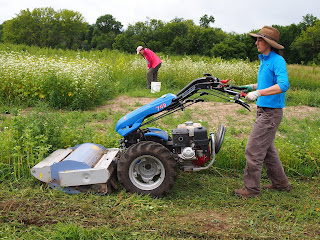Author: Vivian Wauters, PhD student, Applied Plant Sciences - Agroecology
As the daily high temperatures slowly drift downward, and fall vegetable crops start to appear at the farmers markets, there might be some open space on your farm that won’t be planted to vegetables until next year. If so, one option could be to try out fall-seeded cover crops!
Why fall-seeded cover crops?
As the daily high temperatures slowly drift downward, and fall vegetable crops start to appear at the farmers markets, there might be some open space on your farm that won’t be planted to vegetables until next year. If so, one option could be to try out fall-seeded cover crops!
Why fall-seeded cover crops?
Cover crops can contribute to soil organic matter, suppress weeds, add N (legumes only), protect soil from erosion, and soak up excess nutrients in the soil, preventing leaching, among others. In some Minnesota vegetable rotations, there are fields that are finished before the first frosts (e.g. peppers or summer squash), and without planting anything else, they would lie bare during the whole winter. The bare soil would be vulnerable to erosion and nutrient leaching, but by planting a cover crop, you can protect the soil and the nutrients in it, and maybe even get a head start on soil fertility for the next season.
Good species mixtures?
Good species mixtures?
Fall-seeded cover crops are often used to get some plant coverage on the soil before temperatures drop and snow covers the soil. There are two main types of fall cover crops: winter-killed and over-wintered. Winter-killed, as the name suggests, are cover crops that are not winter-hardy, and will die off in the late fall. Common species mixtures for winter-killed cover crops include oats, peas, and tillage radish. In contrast, overwintered cover crops consist of winter-hardy species: the most common combination is winter rye and vetch.
Major management considerations?
Major management considerations?
Management will depend on whether you choose a hardy or non-hardy cover crop, and that should be determined by what you anticipate using the field for in 2020. For example, a field that had summer peppers on it this year and will have onions next year needs to be available early in the spring, and therefore you should choose winter-killed cover crop species, which will die from the cold and begin to decompose over the winter, allowing you to get into and prep the field early in the spring. In contrast, if you have available land that won’t be planted until later June next year, you could plant a winter-hardy cover crop; this crop will grow some in the fall, then die back a bit over the winter, and re-grow in the spring. For termination, you’ll want a decent mower that can handle tall, fibrous grass stalks (if you plant rye), and ideally a mower that will chop up the cover crop so that it decomposes faster.
Ready to get some seed?
The UMN cover crops research lab uses a flail mower to mow and chop cover crops. Photo: Vivian Wauters.
Ready to get some seed?
Choose a species or mixture and calculate quantities using the cover crop chart at https://z.umn.edu/covercropchart. Estimated costs are provided per acre and per 1000 ft2. A common winter-killed mixtures is oats and field peas. A common winter-hardy mixture is rye and vetch. Tillage radish could be added as a winter-killed species to either mixture to provide biomass and remediate soil compaction.
Want to know more?
Want to know more?
NC-SARE has many resources on specific cover crop species and mixes, and suggestions for planting rates, dates, and termination. In particular, Managing Cover Crops Profitably is an invaluable resource for the novice or expert cover crop user, and is available via a free online version!

Comments
Post a Comment